For the highest quality remote patient management, it is essential to take into account the following keys:
- Reliability and security of technology: Use platforms and devices that are secure and reliable to guarantee the integrity of the patient’s medical data.
- Interoperability: Asegurar que los sistemas utilizados puedan integrarse con otros sistemas de salud para compartir datos de manera efectiva y facilitar el uso a los facultativos y la coordinación entre diferentes profesionales de la salud.
- Ease of use: The technology employed should be intuitive and easy to use for both patients and healthcare professionals, allowing for rapid and smooth adoption.
- Accessibility: Ensure that the technology is accessible to all patients, regardless of their geographic location, socio-economic status or digital skills.
- Personalisation: Tailor technology solutions to the specific needs of each patient, providing a personalised and individual-centred approach.
- Continuous monitoring: Implement systems that enable continuous monitoring of patients, with automatic alerts to detect changes in their health status and facilitate early interventions.
- Effective communication: Facilitate two-way communication between patients and healthcare professionals through tools such as secure messaging, video calls and chatbots, to resolve queries and provide real-time support.
- Data analytics: Use advanced data analytics to identify patterns, trends and potential risks in patient health, enabling informed and proactive decision-making.
- Training and support: Provide adequate training to both patients and healthcare professionals in the use of the technology, and offer ongoing technical support to resolve any issues that may arise.
Key factors
Achieving quality remote patient management involves several key factors encompassing both the appropriate use of technology and patient-centred care.
Appropriate Technology and Equipment
The first step to effective remote management is the implementation of a robust technology infrastructure. This includes secure and easy-to-use telemedicine platforms, accurate remote monitoring devices (such as oximeters, glucometers, and blood pressure monitors) and data management systems that allow for real-time integration and analysis of information. Interoperability between different systems is crucial to ensure that patient data can be shared and used efficiently.
Training and Education
Medical staff and patients should be adequately trained in the use of these technologies. Physicians should receive ongoing training on telemedicine best practices, the use of remote monitoring devices and their benefits in clinical practice. Similarly, patients and their families need to understand how to use these devices and platforms, as well as the importance of maintaining open and constant communication with their healthcare team
Patient-centred approach
Quality remote management must focus on the needs of the patient. This involves not only monitoring vital signs, but also attention to psychological and emotional aspects. Virtual consultations should be empathetic and personalised, allowing patients to feel that they are receiving care comparable to face-to-face. Accessibility is another vital aspect, ensuring that all patients, regardless of their technological skills or socio-economic status, can access remote care.
Regulation and Security
Data security is another key pillar. Platforms must comply with privacy and data security regulations, such as the General Data Protection Regulation (GDPR) in Europe or the Health Insurance Portability and Accountability Act (HIPAA) in the US. This includes data encryption, strict access controls and regular audits to prevent security breaches.
Evaluation and Continuous Improvement
Finally, continuous evaluation and adjustment of processes is essential. Gathering feedback from patients and medical staff helps identify areas for improvement. Analysis of this data can guide the implementation of changes that optimise patient experience and service efficiency.
Conclusions
To achieve the desired quality, it is essential to have the most relevant technologies: Internet of Things, which includes sensors, wireless devices, telemedicine platforms and mobile health applications; Big data and Artificial Intelligence (AI), providing health data management platforms and advanced data analytics; and Blockchain.
In short, quality remote patient management requires a combination of advanced technology, appropriate education and training, a patient-centric approach, compliance with data security regulations and a constant commitment to continuous evaluation and improvement. With these elements, it is possible to provide remote healthcare that is effective, safe and humanised.








